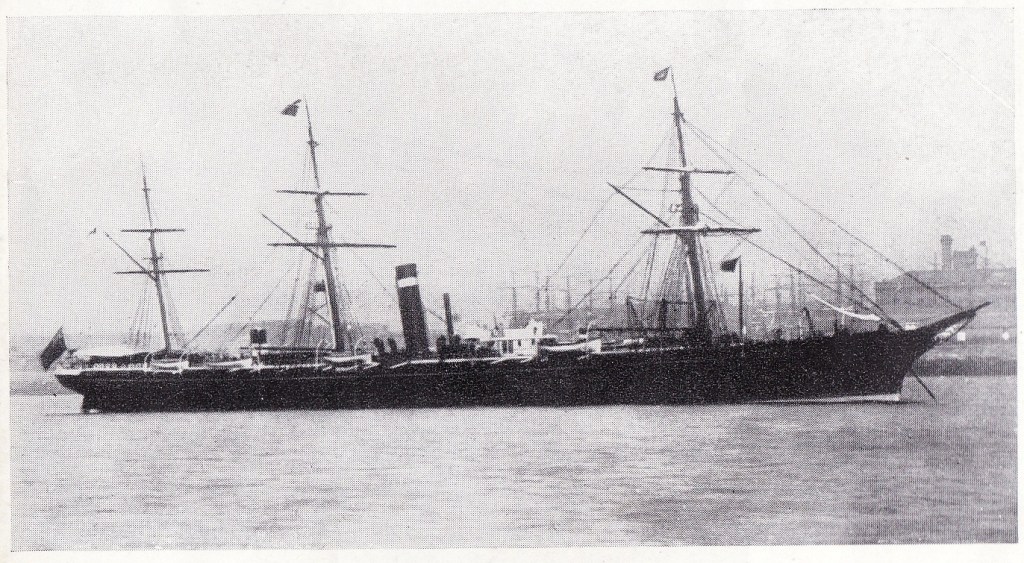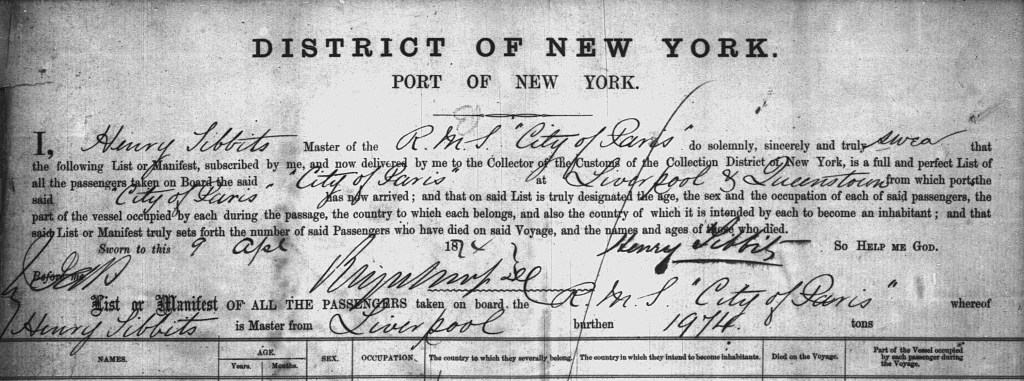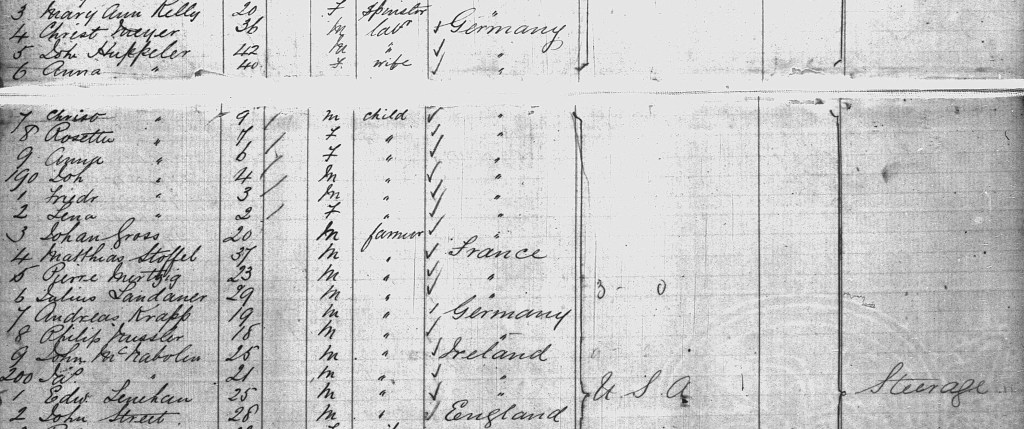On an early spring day in 1874, the R. M. S. City of Paris arrived at the Port of New York. This ship had been serving as a passenger liner since 18661 and its record as a fast ship along with the records of the other four or five ships in its fleet contributed to its owners being granted a contract to transport mail by the British Post Office Government.2 Thus it holds the prefix “R. M. S.” which means Royal Mail Steamship.3 It was an iron-hulled, screw-propelled steamship, but it was fitted with sails also in order to navigate in unpredictable weather. (Initially, steamships were propelled by paddlewheel. The first screw-propelled steamship was built in 1840.4 Screw-propellers became the standard mode of propelling steamships until they were replaced by steam turbines in the early 1900s. The transition from wood hulls to iron hulls began about 1850.5) “After four years of service, City of Paris was lengthened to 397 feet (121 meters) and re-engined with compounds …. This raised her tonnage to 3100 and her capacity to 150 cabin and 400 steerage.”6

On April 9, 1874, Henry Tibbits, the Master of the R. M. S. City of Paris, submitted a ship manifest to the Collector of the Customs of the Collection District of New York. Listed on this ship manifest as one of the families who traveled in steerage is the Huppeler family, which included:
#185 Joh Huppeler, age 42, male, laborer
#186 Anna Huppeler, age 40, female, wife
#187 Christ Huppeler, age 9, male, child
#188 Rosetta (sp) Huppeler, age 7, female, child
#189 Anna Huppeler, age 6, female, child
#190 Joh Huppeler, age 4, male, child
#191 Friedr Huppeler, age 3, male, child
#192 Lena Huppeler, age 2, female, child


On this manifest, the country recorded to which the Huppelers belonged was Germany, and decades later the son John Huppler reported on his petition for naturalization that he had emigrated from Hamburg, Germany.9 Yet the naturalization documents of Christian, Anna, John and Lena Huppler indicate that they had been subjects of Switzerland.10 The R. M. S. City of Paris picked up passengers in Liverpool, England and Queenstown, Ireland. At this point, it is not known exactly how long this specific voyage across the Atlantic Ocean was, but it is recorded that “In a famous February 1868 race, City of Paris and Russia sailed from New York within an hour of each other. The Inman liner [City of Paris] claimed 8 days, 19 hours, 23 minutes to Queenstown, while the Cunarder [Russia] required 42 minutes longer using a slightly different course.”11
The ship manifest also records that the Huppeler family intended to become inhabitants of the United States of America. When they disembarked from the ship they would have been processed as immigrants at Castle Gardens, New York City.
“Prior to 1890, individual states (rather than the federal government) regulated immigration into the United States. These regulation efforts were varied and inconsistent. …
“On August 1, 1855, the [state of] New York opened the first official immigrant receiving station in New York City. It functioned as an immigrant processing center and was the first of its kind in the United States. Castle Gardens operated as an Emigrant Landing Depot until April 18, 1890, when the United States government assumed control of immigrant processing. In total, the center processed approximately 8 million immigrants (mostly from northern and western Europe).
“When immigrants disembarked at Castle Garden, they had to register with their name, birth place, and destination. A clerk at the Railway Agency would then purchase a railway ticket for the immigrant to travel to that destination. The immigrant’s baggage would be weighed and checked to his destination. Exchange brokers for immigrants to exchange foreign currency and a restaurant were also located at the center. A station for [letter] writing was also available, in which an immigrant could send a letter free of charge to inform family or friends of their arrival. The Ward’s Island and medicinal department was an important bureau at Castle Garden. There, immigrants without the means to support themselves would be cared for until assistance came from friends or the immigrants would be disposed of as laborers. A large blackboard with the names of ships who were or would shortly be at port was kept for friends of the immigrants to know when they arrived and locate them. The Labor Exchange was where immigrants, and others, could apply for and generally find employment. Immigrants could also find boarding houses to rest for one or two days before heading out to their destinations.
“Castle Gardens was a very busy and important immigrant receiving station. To illustrate, in 1869, 2884 letters written from immigrants to their friends were forwarded, over $41,000 was sent from these friends in return. Also in 1869, 4393 telegraph messages were forwarded and 1351 answers were received. Also, 504 steamers and 209 sailing vessels arrived carrying passengers.”12
Five years earlier than when John Huppeler’s family arrived at New York City, another Huppeler family had immigrated to the United States – the family of John’s brother. The ship manifest of the S. S. William Penn (“S. S.” means single-screw steamship13) lists the following members:
#259 Jacob Huppeler, age 42, male
#260 Catherine Huppeler, age 52, female
#261 Anna Lise Huppeler, age 11, female
#262 Catharine Huppeler, age 9, female
This steamship had picked up passengers in London, England and in Havre, France. This Huppeler family had traveled in steerage, the country to which they belonged was recorded as Switzerland and they intended to become inhabitants of the United States. Of the 613 passengers listed on the ship manifest, 158 of them were from Switzerland.



Notes:
- “SS City of Paris (1865)” (November 16, 2019), https://en.wikipedia.org/wiki/SS_City_of_Paris_(1865).
- “SS City of Paris (1865)” (November 16, 2019), https://en.wikipedia.org/wiki/SS_City_of_Paris_(1865).
- “Steamship” (December 17, 2019), https://en.wikipedia.org/wiki/Steamship#Name_prefix.
- “Steamship” (December 17, 2019), https://en.wikipedia.org/wiki/Steamship#First_ocean-going_steamships.
- “Inman Line” (November 18, 2019), https://en.wikipedia.org/wiki/Inman_Line#1850–66.
- “SS City of Paris (1865)” (November 16, 2019), https://en.wikipedia.org/wiki/SS_City_of_Paris_(1865).
- “File:City of Paris (1866).jpg” (September 7, 2009, https://commons.wikimedia.org/wiki/File:SS_City_of_Paris_1866.jpg.
- “New York Passenger Lists, 1820-1891,” database with images, FamilySearch (https://familysearch.org/ark:/61903/1:1:QK97-V815 : 11 March 2018), John Huppeler, 1874; citing Immigration, New York City, New York, United States, NARA microfilm publication M237 (Washington, D.C.: National Archives and Records Administration, n.d.), FHL microfilm 175,744.
- United States of America, “Petition for Naturalization: Monroe County, Wisconsin,” February 26, 1892 (NAT reel 8, p. 63).
- Microfilm images of naturalization papers of Christian Huppler, Anna E. Huppler, John Huppler and Lena Huppler, South Dakota State Historical Society, Pierre, South Dakota.
- “SS City of Paris (1865)” (November 16, 2019), https://en.wikipedia.org/wiki/SS_City_of_Paris_(1865).
- Becca Curtis, “US Immigration History” (August 17, 2018), https://www.familysearch.org/wiki/en/US_Immigration_History.
- “Steamship” (December 17, 2019), https://en.wikipedia.org/wiki/Steamship#Name_prefix.
- “New York Passenger Lists, 1820-1891,” database with images, FamilySearch (https://familysearch.org/ark:/61903/1:1:QV3Q-S25K : 11 March 2018), Jacob Huppelar, 1869; citing Immigration, New York City, New York, United States, NARA microfilm publication M237 (Washington, D.C.: National Archives and Records Administration, n.d.), FHL microfilm 175,664.
I found the timing of this blog ironic and timely!
As it turns out, I am currently in Grindelwald, Switzerland, a canton of Bern. Might you have any information about where in Switz Lena and family were from. Interestingly enough, when I did my 23&Me DNA test, I come up 31% Swiss and perhaps some German.
Faith Galati faithgalati@gmail.com
>
LikeLike
I have gathered some information from notes that I have obtained from research cousins. I have not verified any of this information.
1. A document of Johann Hüpplen and family identifies their home as Twp-Diesbach; County-Konolfingen; Canton-Bern.
2. A couple sources say that Lena’s brother Christian was born in Kluxenberg, Switzerland, but one of our research cousins says that he has not been able to locate any place with that name. Another source says the family came from Klucksenburg, Switz.
3. There is the possibility that Lena’s sister Anna was christened in Escholzmatt, Luzerne, Switzerland, based on a document naming father Johannes Huppler and mother Anna Waelti. Another source says she was born in Bern, Switz.
4. Lena’s brother Friedrich may have been baptized in County of Bern, District of Konopfingen, Parish of Kurzenberg, based on a document certifying parents Johannes Huppeler of Diesbach and Anna Multi.
5. Lena’s brother John may have been baptized in Canton Bern, County-Signau, Twp-Rothenberg, based on a baptismal record naming father Johannes Huppeler and mother Anna Muktiz. Another source says he was born in Bern, Switz.
6. The death certificate of Katherine Dellman (dau. of Jacob Huppeler) says that she was born in Bern, Switzerland.
LikeLike
[…] John and Anna Huppeler1, with their six children, arrived at the Port of New York in April 1874.2 Two months later, at the Circuit Court of Monroe County, […]
LikeLike
[…] Immigrated with her parents to the USA in 1874 […]
LikeLike